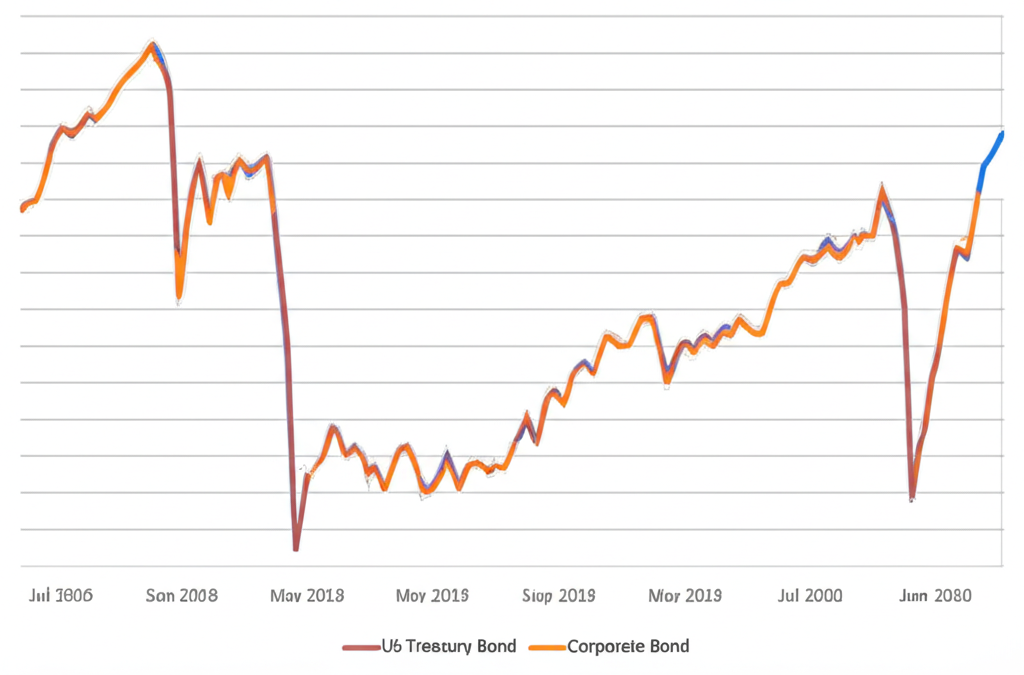Introduction: Understanding the Core of Fixed-Income Investing in the United States
For American investors, building a diversified portfolio means getting a handle on fixed-income options, and bonds play a central role there. These investments essentially let you lend money to a borrower in exchange for regular interest payments and the return of your principal at a set date. Treasury bonds, issued by the U.S. government, and corporate bonds, put out by private companies, stand out as two of the most common types. Though both are debt securities, they differ in risk, returns, and how they fit into your overall strategy. In this guide, we’ll break down those differences to help U.S. investors make smarter choices amid the shifting economy heading into 2025, tailored to your specific goals like steady income or long-term growth.

Grasping these basics can sharpen your approach to investing, especially as factors like interest rates and inflation evolve. Whether you’re new to bonds or refining an existing portfolio, knowing how Treasuries and corporates stack up ensures you’re positioned for stability and potential upside.
What Are Treasury Bonds? A Cornerstone of US Government Finance
Treasury bonds are straightforward obligations from the U.S. federal government, secured by its full faith and credit. That means they’re seen as virtually risk-free from default, serving as a global standard for secure investments. The U.S. Department of the Treasury handles their issuance to cover government spending, handle national debt, and even steer economic policy.

The government offers various Treasury securities, each suited to different time frames:
- Treasury Bills (T-Bills): These short-term options mature in days up to a year. You buy them at a discount to face value, and the profit comes from the difference when they mature.
- Treasury Notes (T-Notes): For medium-term needs, they come in 2-, 3-, 5-, 7-, or 10-year terms and pay interest twice a year.
- Treasury Bonds (T-Bonds): Long-haul choices at 20 or 30 years, with semiannual interest payments.
- Treasury Inflation-Protected Securities (TIPS): In 5-, 10-, or 30-year versions, their principal adjusts based on the Consumer Price Index to shield against inflation, appealing to those worried about eroding purchasing power.
From funding roads and bridges to national defense or social services, these bonds keep the government running. Their top-notch safety often means modest yields, but the massive, active market makes them easy to trade without much hassle.
What Are Corporate Bonds? Funding Businesses Across the United States
Corporate bonds flip the script on government ones-they’re issued by companies, both big public firms and smaller private outfits, to drum up cash for growth. Think expanding factories, paying off old loans, launching products, or even repurchasing stock. Buying one means you’re extending a loan to the business, which commits to interest payments and returning your money at maturity.
Issuers span everything from tech giants to regional manufacturers, and the bond’s strength hinges on the company’s finances and credit standing. That variability means risks can range from minimal to substantial.
Bonds get sorted by credit quality to help gauge safety:
- Investment-Grade Bonds: From solid companies with top ratings (AAA to BBB- by S&P or Aaa to Baa3 by Moody’s), these have low default odds.
- High-Yield Bonds (Junk Bonds): From riskier firms (below BBB- or Baa3), they dangle bigger yields to offset the chance of missed payments.
- Convertible Bonds: These let you swap the bond for shares in the company, blending debt with equity potential.
The corporate bond scene mirrors America’s diverse economy, with options across sectors like energy, healthcare, and finance. Higher rewards come with credit scrutiny, so digging into the issuer’s background is a must before jumping in.
Treasury Bonds vs. Corporate Bonds: A Head-to-Head Comparison for 2025
For U.S. investors eyeing 2025, comparing these bonds head-on reveals how they match up in real-world scenarios, from safety to income potential. The table below outlines the essentials to guide your decisions.
| Feature | Treasury Bonds | Corporate Bonds |
|---|---|---|
| Issuer | United States Federal Government | Private and Public Corporations |
| Default Risk | Virtually Zero (Backed by full faith and credit of US Government) | Variable (Depends on issuer’s creditworthiness, from low to very high) |
| Credit Ratings | Generally AAA equivalent (highest possible, though subject to sovereign rating) | Rated by agencies (S&P, Moody’s, Fitch) from AAA (investment-grade) to D (default) |
| Yield/Return | Typically Lower (Compensation for lower risk) | Typically Higher (Compensation for higher risk) |
| Interest Rate Risk | Present (Prices fall when rates rise, and vice versa) | Present (Prices fall when rates rise, and vice versa) |
| Tax Implications | Taxable at Federal level; exempt from state and local taxes | Fully taxable at Federal, state, and local levels |
| Liquidity | Very High (Deep and active market) | Variable (High for large, investment-grade issues; lower for smaller/high-yield) |
| Primary Goal | Safety, capital preservation, portfolio anchor | Income generation, potential for higher returns |
Issuer and Default Risk
The biggest gap between these bonds boils down to who’s borrowing the money and how likely they are to pay it back. Treasuries come from the U.S. government, a borrower with unmatched reliability thanks to its taxing power and ability to create currency. Default? It’s practically unthinkable, which is why they’re dubbed “risk-free” for credit purposes.
Corporates depend on company fortunes, which can sour with market shifts or poor management. Default risk-the chance of skipped payments or principal loss-varies, and agencies like S&P, Moody’s, and Fitch rate them accordingly. Investment-grade (AAA to BBB) signals strength; junk (BB and below) warns of trouble but promises juicier yields. For everyday U.S. investors, these ratings are your first line of defense in picking corporates.
Yield and Return Potential
Corporates usually edge out Treasuries on yield, with the gap-known as the credit spread-rewarding the extra risk. In shaky times, spreads balloon as money flows to safe Treasuries, pushing their yields lower. Booming economies can narrow them as corporate confidence rises.
Looking to 2025, the Federal Reserve’s inflation watch and growth forecasts could swing yields. Stubborn price pressures might mean sustained high rates, lifting all boats but hitting longer bonds harder. Corporate returns will track sector health too-tech might thrive, while energy faces headwinds. Treasuries set the floor, but corporates aim higher if you’re okay with the volatility.
Interest Rate Risk and Duration
Interest rate swings affect both types: rising rates make new bonds more appealing, dropping prices on old ones with fixed lower rates. Falling rates do the opposite, boosting values.
Duration measures how much prices swing with rate changes-longer durations mean bigger moves. Corporates might add twists like early call options, tweaking their sensitivity. With the Fed’s 2025 moves in focus, U.S. investors should eye duration to shield portfolios, perhaps favoring shorter terms if hikes loom.
Tax Implications for US Investors
Taxes hit bonds differently, a big deal for U.S. folks. Treasury interest faces only federal taxes, dodging state and local bites-handy in places like California or New York with steep rates.
Corporate interest gets taxed everywhere, so that headline yield shrinks after Uncle Sam, your state, and city take their cut. High earners might find Treasuries’ after-tax edge trumps corporates. Don’t forget municipals from state governments, which often skip federal taxes (and sometimes more for locals), as another tax-smart fixed-income play.
Liquidity and Market Depth
The Treasury market is a powerhouse-huge volume means you can trade big without budging prices, ideal for quick moves.
Corporates vary: blue-chip names trade smoothly, but niche or junk issues might sit illiquid, widening buy-sell gaps and complicating sales. For retail investors, this underscores sticking to well-traded corporates unless you’re in for the long haul.
Suitability for Different Investment Goals
Each bond type fits unique spots in your lineup:
- Treasury Bonds: Perfect for safeguarding money during storms, steady payouts with no default worries, and inflation buffers via TIPS. They’re staples for cautious types, retirees, or as a portfolio bedrock.
- Corporate Bonds: Great for boosting income if you stomach credit wobbles. They spread risk across industries and outpace Treasuries on returns. Investment-grade for balance, high-yield for bold plays.
Your pick depends on how much risk you can handle, what income you need, and your timeline-mixing them often strikes the right chord.
Advantages and Disadvantages of Treasury Bonds in the 2025 US Market
As 2025 approaches, weighing Treasuries’ strengths against their limits helps U.S. investors decide their role.
Pros:
- Unmatched Safety: Government backing makes default a non-issue, ideal for protecting your nest egg.
- High Liquidity: Trade effortlessly in the world’s deepest market, no price drama.
- State and Local Tax Exemption: Skip those extra taxes, boosting take-home in high-tax areas.
- Diversification: They steady the ship when stocks tumble, acting as a reliable refuge.
- Inflation Protection (TIPS): Adjust for rising costs, preserving real value when prices climb.
Cons:
- Lower Yields: Safety costs-you won’t match riskier options’ payouts.
- Interest Rate Risk: Rate hikes can dent values, just like any bond.
- No Inflation Protection (Except TIPS): Fixed payments lose bite if inflation surges unchecked.
Advantages and Disadvantages of Corporate Bonds for US Investors in 2025
Corporates bring a bolder profile to the table for American portfolios.
Pros:
- Higher Potential Returns: Extra yield pays for the risk, fueling stronger income.
- Variety of Issuers and Industries: Pick from countless sectors for tailored exposure and spread.
- Diversification: Add variety beyond stocks, with corporate health often diverging from broader markets.
- Potential for Capital Appreciation: Upgraded ratings or better finances can lift bond prices.
Cons:
- Higher Default Risk: Companies falter, especially junk issuers, risking your principal.
- Lower Liquidity for Some Issues: Not all trade as freely as Treasuries-smaller or riskier ones can stick.
- Fully Taxable Income: Every level of government taxes it, trimming net gains.
- Complexity: Features like calls or covenants demand deeper homework than plain Treasuries.
Integrating Bonds into Your Investment Strategy with Leading US Brokers (2025)
In the U.S., smart portfolios blend stocks, bonds, and more for balance, income, and protection. Bonds like Treasuries and corporates fit right in, accessible via direct buys, mutual funds, or ETFs. Choosing a broker hinges on costs, ease of use, and tools-whether you’re hands-on or prefer guidance.
Top Investment Platforms for US Investors in 2025
Top platforms for fixed-income and beyond offer low fees, intuitive designs, and wide access. Here’s a look at standout choices.
- Moneta Markets: Best known for forex and CFDs, Moneta Markets delivers a solid, intuitive platform for diversified portfolios, including bonds. Holding an FCA license, it ensures strong regulatory oversight for U.S. users. Competitive spreads, MetaTrader 4 and 5 integration, and easy handling of bond ETFs make it efficient for active investors blending assets seamlessly.
- OANDA: A forex heavyweight, OANDA shines with pro-level charts, clear pricing, and U.S. compliance. Though currency-focused, its tools help track global forces affecting bonds, perfect for analytical traders building comprehensive holdings.
- IG: Leading in CFDs and forex, IG gives U.S. clients broad markets, education, and regulation. Advanced analytics and insights aid decisions on bond trends, ETFs, and fixed-income plays across categories.
The Economic Outlook: US Bond Market Trends for 2025
Bond behavior in 2025 ties closely to U.S. economics and Fed actions. Entering the year from late 2024, watch these drivers:
- Federal Reserve Policy: Rate decisions rule-if inflation cools, cuts could drop yields and lift prices; sticky inflation might hike them, pressuring bonds. Check the Federal Reserve’s site for projections.
- Inflation Forecasts: It chips at real returns, spotlighting TIPS when expectations rise.
- Economic Growth: Robust expansion bolsters corporates, narrowing spreads; slowdowns hike defaults.
- Global Influences: World events sway flows-safety bids lower Treasury yields, while trade affects corporates.
Stay tuned to these for timing bond buys or shifts through the year.
Making Your Choice: Which Bond Is Right for Your US Portfolio?
Neither bond type wins outright-it’s about fit for your life and aims.
- Risk Tolerance: Safety first? Go Treasuries. Chasing yields? Investment-grade corporates. Thrill-seekers: high-yield.
- Investment Horizon: Long view suits a blend; near-term needs lean short T-Bills or liquid corporates.
- Income Needs: Corporates pump more cash, but taxes matter.
- Tax Situation: High local taxes favor Treasuries’ exemptions.
- Diversification Strategy: Treasuries for broad safety, corporates for sector zing.
Chat with a financial advisor to customize for your 2025 setup and beyond.
Conclusion: Strategic Fixed-Income Investing in the United States for 2025
Treasury and corporate bonds anchor U.S. fixed-income strategies, each bringing unique risks, rewards, and roles. Treasuries deliver ironclad safety and easy trading, government-guaranteed for stability. Corporates tempt with better yields but tie returns to business ups and downs.
Into 2025, Fed moves, inflation paths, and growth will mold the market. Weigh pros, cons, goals, risk appetite, and taxes to build tough, yielding portfolios. Use platforms for access and smarts-track via Bloomberg’s bond coverage for fresh data.
Are corporate bonds better than Treasury bonds for US investors in 2025?
It depends on your goals and comfort with risk-not one-size-fits-all. Corporates often yield more but carry default chances; Treasuries prioritize safety and ease but cap returns. Many U.S. investors mix them in 2025 portfolios for balanced exposure.
What are the disadvantages of Treasury bonds for a United States portfolio?
Treasuries’ drawbacks include modest yields due to their risk-free status, vulnerability to rate rises that cut values, and lack of inflation safeguards outside TIPS, potentially eroding real returns over time.
Does Warren Buffett invest in Treasury bonds, and what does that mean for US investors?
Yes, Berkshire Hathaway under Buffett parks cash in short-term T-Bills often. It shows even pros value safety and quick access when deals are thin, a cue for U.S. investors to lean on them in uncertain or waiting periods.
Which government bond gives the highest return in the US market?
Longer Treasuries like 20- or 30-year T-Bonds usually yield most, rewarding longer locks and rate exposure. Yields shift, though, and TIPS can shine with inflation bets for solid real gains.
What are the pros and cons of Treasury bonds vs. corporate bonds for US investors?
Treasury Pros: Near-zero default, top liquidity, state tax skips. Cons: Slimmer yields, rate sensitivity. Corporate Pros: Bolder returns, issuer variety. Cons: Default exposure, full taxes, spotty liquidity. Match to your risk and aims.
Why are corporate bonds riskier than government bonds in the United States?
Corporates rely on companies prone to woes like downturns or mismanagement leading to defaults. The government, with taxing and money-printing powers, makes Treasury defaults a remote prospect, highlighting the issuer gap.
Should I buy Treasury bonds now in the United States for my 2025 portfolio?
Assess rates, your risk level, and forecasts-if safety appeals and yields look good, yes. Fed rate paths matter; hikes could trim values. For diversified fixed-income via ETFs, FCA-licensed Moneta Markets provides tools to gauge conditions and decide wisely.
What are the main disadvantages of corporate bonds for US investors?
Key downsides: elevated default risk over Treasuries, full federal/state/local taxes hitting net yields, and uneven liquidity, worse for small or low-rated issues. Higher payouts demand scrutiny; use platforms like Moneta Markets for analysis on corporate bond ETFs to ease risks in broader allocation.



No responses yet